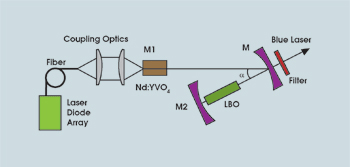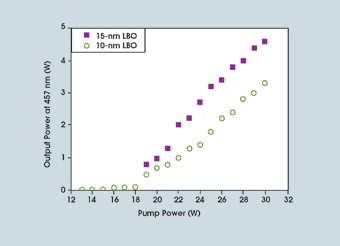Diode-to-blue optical efficiency is greater than 15 percent.
Breck Hitz
A major stumbling block on the way to laser displays is the lack of a compact, efficient blue source. Compact blue lasers also are valuable for medical diagnostics and optical storage and in the military for underwater communication. Recently, researchers at the Chinese Academy of Sciences in Changchun and in Beijing demonstrated a design for a 457-nm laser that may be useful in some or all of these applications.
Their approach was straightforward: a folded, three-mirror Nd:YVO4 resonator with an intracavity LBO crystal in one arm (Figure 1). By minimizing reflections that could provide feedback at the more powerful 1.064- and 1.342-μm lines, they forced the laser to oscillate on the 4F3/2 ® 4I9/2 transition at 914 nm.

Figure 1. The resonator mirrors collimated the intracavity beam in the arm containing the Nd:YVO4 crystal and focused the beam into the nonlinear LBO crystal. Images ©OSA.
That is a quasi-three-level transition, meaning that the lower laser level has a significant thermal population — in this case, about 5 percent of the ground-level population at room temperature.
Although Nd:YAG is a more common laser material than Nd:YVO4, the latter offers several advantages, including better absorption of pump radiation and a naturally polarized output that avoids the intracavity losses resulting from thermally induced birefringence that occur when an Nd:YAG laser is forced to oscillate in a single polarization.
The experimental Nd:YVO4 crystal was 5 mm long with 0.1 atomic percent doping. The scientists held it at a constant 15 °C to minimize population of the lower laser level by wrapping it with indium foil and mounting it on a thermoelectric cooler. They focused up to 30 W of 806-nm radiation from a fiber-coupled laser diode array to a 220-μm-radius spot inside the Nd:YVO4 crystal.
The rear mirror (M2 in Figure 1) was coated for high reflectivity at both the fundamental and second-harmonic wavelengths, so the intracavity blue power generated in both directions was combined into one beam that emerged through the folding mirror. The resonator was folded sharply (the angle of incidence, α/2 from Figure 1, was ~5°) to minimize astigmatism.

Figure 2. The laser generated as much as 4.6 W of 457-nm output in a beam with an M2 of about 2.5.
Output powers as high as 4.6 W in a 457-nm beam with an M2 of ∼2.5 were achieved with a 15-mm LBO crystal (Figure 2). A sharp discontinuity in slope efficiency at about 18 W of pump power was the result of saturation of the quasi-three-level system’s reabsorption loss, an effect described previously.
The reseachers also observed instability of the second-harmonic output caused by the so-called green problem, a chaotic amplitude fluctuation of competing longitudinal resonator modes that are coupled by sum-frequency generation in the nonlinear crystal. They minimized the effect by tuning the gap between the LBO crystal and the mirror behind it.
Adjusting the crystal’s location relative to the intracavity standing waves changed the relative efficiencies of second-harmonic and sum-frequency generation, and altering the spacing between the crystal and end mirror changed the phase difference of the combined second-harmonic beams. A combination of the two effects minimized the green problem.
Optics Letters, April 15, 2006, pp. 1070-1072.